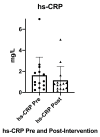Efficacy of the Autoimmune Protocol Diet as Part of a Multi-disciplinary, Supported Lifestyle Intervention for Hashimoto's Thyroiditis
- PMID: 31275780
- PMCID: PMC6592837
- DOI: 10.7759/cureus.4556
Efficacy of the Autoimmune Protocol Diet as Part of a Multi-disciplinary, Supported Lifestyle Intervention for Hashimoto's Thyroiditis
Abstract
Background Hashimoto's thyroiditis (HT), also known as chronic lymphocytic thyroiditis, is an autoimmune disorder affecting the thyroid gland and is the most common cause of hypothyroidism in the US. Despite medical management with thyroid hormone replacement, many individuals with HT continue to experience symptoms and impaired quality of life. Given the limited number of efficacious treatments outside of hormone replacement and the overall burden of continued symptomatic disease, this pilot study was designed to determine the efficacy of a multi-disciplinary diet and lifestyle intervention for improving the quality of life, clinical symptom burden, and thyroid function in a population of middle-aged women with HT. Materials and methods The study recruited 17 normal or overweight (body mass index (BMI) <29.9) female subjects between the ages of 20 and 45 with a prior diagnosis of HT. The 17 women participated in a 10-week online health coaching program focused on the implementation of a phased elimination diet known as the Autoimmune Protocol (AIP). The 36-Item Short Form Health Survey (SF-36) and Cleveland Clinic Center for Functional Medicine's Medical Symptoms Questionnaire (MSQ) were used to measure the participant's health-related quality of life (HRQL) and clinical symptom burden, respectively, before and after the 10-week program. The participants completed serologic testing that included a complete blood cell count (CBC) with differential, complete metabolic profile (CMP), thyroid function tests, including thyroid stimulating hormone (TSH), total and free T4, and total and free T3, thyroid antibodies, including thyroid peroxidase antibodies (TPO) and anti-thyroglobulin antibodies (TGA), and high-sensitivity C-reactive protein (hs-CRP). Results Sixteen women (n = 16) completed the SF-36 and MSQ before and after the 10-week program. There was a statistically significant improvement in HRQL as measured by all eight subscales of the SF-36 with the most marked improvements noted in the physical role functioning, emotional role functioning, vitality, and general health subscales. The clinical symptom burden, as measured by the MSQ, decreased significantly from an average of 92 (SD 25) prior to the program to 29 (SD 20) after the program. There were no statistically significant changes noted in any measure of thyroid function, including TSH, free and total T4, free and total T3 (n = 12), as well as thyroid antibodies (n = 14). Inflammation, as measured by hs-CRP (n = 14), was noted to significantly decrease by 29% (p = 0.0219) from an average of 1.63 mg/L (SD 1.72) pre-intervention to 1.15 mg/L (SD 1.31) post-intervention. Conclusions Our study suggests that an online diet and lifestyle program facilitated by a multi-disciplinary team can significantly improve HRQL and symptom burden in middle-aged female subjects with HT. While there were no statistically significant changes noted in thyroid function or thyroid antibodies, the study's findings suggest that AIP may decrease systemic inflammation and modulate the immune system as evidenced by a decrease in mean hs-CRP and changes in white blood cell (WBC) counts. Given the improvements seen in the HRQL and participants' symptom burden as well as markers of immune activity and inflammation, further studies in larger populations implementing AIP as part of a multi-disciplinary diet and lifestyle program are warranted.
Keywords: autoimmune thyroid disease; hashimoto's thyroiditis; health coaching; lifestyle; nutrition; paleo diet; quality of life.
Conflict of interest statement
Angie Alt is co-founder of the health and wellness platform Autoimmune Wellness LLC that seeks to educate and empower individuals to make lifestyle changes in support of living with and healing from autoimmune disease. She has a group online health coaching program SAD to AIP in SIX that was used as the primary intervention for this study.
Figures







References
-
- The incidence of thyroid disorders in the community: a twenty-year follow-up of the Whickham Survey. Vanderpump MP Vanderpump MP, Tunbridge WM Tunbridge WM, French JM, et al. Clin Endocrinol (Oxf) 1995;43:55–68. - PubMed
-
- Disease-specific as well as generic quality of life is widely impacted in autoimmune hypothyroidism and improves during the first six months of levothyroxine therapy. [Oct;2018 ];Winther KH, Cramon P Cramon P, Watt T, et al. https://www.ncbi.nlm.nih.gov/pmc/articles/PMC4892657/ PLoS One. 2016 11:0. - PMC - PubMed
-
- Hashimoto's thyroiditis affects symptom load and quality of life unrelated to hypothyroidism: a prospective case-control study in women undergoing thyroidectomy for benign goiter. Ott J, Promberger R, Kober F, Neuhold N, Tea M, Huber JC, Hermann M. Thyroid. 2011;21:161–170. - PubMed
LinkOut - more resources
Full Text Sources
Research Materials
Miscellaneous
